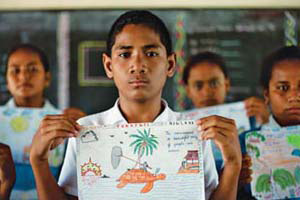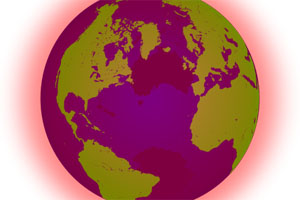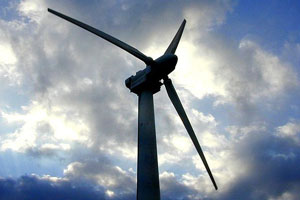
Photo: Robin Hammond
IT’S A BRIGHT, BALMY SUNDAY afternoon and I’m driving through the western outskirts of Auckland, New Zealand, the kind of place you never see on a postcard. No majestic mountains, no improbably green pastures—just a bland tangle of shopping malls and suburbia. I follow a dead-end street, past a rubber plant, a roofing company, a drainage service, and a plastics manufacturer, until I reach a white building behind a chain-link fence. Inside is a kernel of a nation within a nation—a sneak preview of what a climate change exodus looks like.
This is the Tuvalu Christian Church, the heart of a migrant community from what may be the first country to be rendered unlivable by global warming. Tuvalu is the fourth-smallest nation on Earth: six coral atolls and three reef islands flung across 500,000 square miles of ocean, about halfway between Australia and Hawaii. It has few natural resources to export and no economy to speak of; its gross domestic product relies heavily on the sale of its desirable Internet domain suffix, which is .tv, and a modest trade in collectible stamps. Tuvalu’s total land area is just 16 square miles, of which the highest point stands 16 feet above the waterline. Tuvaluans, who have a high per-capita incidence of good humor, refer to the spot as “Mount Howard,” after the former Australian prime minister who refused to ratify the Kyoto Protocol.
The Intergovernmental Panel on Climate Change has warned that low-lying island nations are particularly endangered by rising seas and will also be buffeted by more frequent and more violent storms. Already, warmer ocean temperatures are eating away at the coral reefs that form Tuvalu’s archipelagic spine. Tuvaluans themselves point to more tangible indicators of trouble—the “king tides” that increasingly sluice their homes, the briny water oozing up into the “grow pits” where they used to cultivate taro and other vegetables. As Julia Whitty predicted in this magazine in 2003, the prognosis has become sufficiently dire that the residents of Tuvalu and other low-lying atoll islands “are beginning to envision the wholesale abandonment of their nations.” Around one-fifth of the 12,000-some inhabitants have already left, most bound for New Zealand, where the Tuvaluan community has nearly tripled since 1996.
Inside the church I find a vibrant scene, suggesting both the resilience of Tuvaluan culture and its ability to adapt. Rows of green plastic chairs are filled with several hundred chattering churchgoers, some in traditional lavalavas—vivid cotton skirts emblazoned with flowers—others in Western dresses and suits. A border of bright blue, yellow, and pink stars rings the upper walls—in Tuvalu these might be constructed from frangipani blossoms, but here they are woven from the plastic bands used to tether shipping cargo. As soon as I sit down, a young man in a dapper dark suit strikes up a conversation. He came here in 1997, is making good money, and hasn’t been home once. “You may have heard the news about Tuvalu—with global warming, the sea is rising,” he says cheerfully. “So better we come here to be safe.” Tuvaluans, resigned to fielding reporters’ questions about their homeland’s impending doom, often offer observations like this unprompted.
 The tiny island of Tepuka Savilivili is among those most at risk of disappearing.
The tiny island of Tepuka Savilivili is among those most at risk of disappearing.
After the service, the congregation drifts outside to the gravelly yard, where a group of visitors from the islands is reenacting the crucifixion of Christ on a makeshift stage draped with threadbare astroturf. Reverend Elisala Selu, a thoughtful, soft-spoken man who has worked second jobs to avoid burdening his congregants, explains that Tuvaluan politicians are reluctant to encourage the mass evacuation of their voting base, and so the church, wanting people to be prepared, has taken matters into its own hands. It instructs followers not to assume that, like Noah, they will be delivered by God from the rising waters, and hosts groups of congregants who visit New Zealand to see if they might like to relocate here. But, Selu confides, life in New Zealand isn’t always easy. The Tuvaluans are one of the country’s poorest communities. Just over half the adults have found work; the median income is about $17,000 for men, $10,000 for women. There are those here illegally—overstayers, in Pacific parlance—who struggle to make ends meet; Tuvaluans on the run from debt collectors after buying cars on shady financing schemes; children left unattended for long hours because their parents work multiple jobs as cleaners or laborers or farmworkers. Then there’s the jarring adjustment to urban Auckland from a place where most citizens don’t pay rent or buy food, but sleep on grass mats beside the road on warm nights, go fishing or pick breadfruit when they’re hungry, and where, as one jovial Tuvaluan remarked to me, “the only crime is cycling in the night without a torch [flashlight].” Selu frets about the new generation of Tuvaluan children born in New Zealand. “We try to run away from the sea rise in Tuvalu, but this is another sea-level rise,” he says with a wry smile. “The next generation gets caught by two cultures. Before Tuvalu sinks physically, our identity might sink in a foreign country.”
Tuvalu and other low-lying island countries like Kiribati and the Maldives are, in one sense, the starkest example of how climate change will reshape the world. But Auckland’s Tuvaluan community also represents a best-case scenario—so far their migration has been orderly, and their numbers are minuscule compared with the millions of impoverished people who live in global warming hot spots like Africa’s Sahel, coastal Bangladesh, and Vietnam’s deltas. Koko Warner, an expert on climate change and migration at the United Nations University in Bonn, says the displacement of those populations could be “a phenomenon of a scope not experienced in human history.”
Yet little has been done to prepare. In fact, our understanding of exactly how global warming will affect people—how many lives will be threatened, and what we could do to avert a succession of humanitarian disasters—remains extremely rudimentary. As Bill Gates has caustically observed, “It is interesting how often the impact of climate change is illustrated by talking about the problems the polar bears will face rather than the much greater number of poor people who will die unless significant investments are made to help them.”
IN JUNE, I TRAVELED to the verdant, secluded campus of Columbia University’s Earth Institute, near the New York Palisades, to find out how global warming will reconfigure the world’s political geography. Earth Institute scientists, along with researchers from the United Nations University, have conducted a global study to chart how environmental change will affect vulnerable populations.
Alex de Sherbinin, one of the project’s lead researchers, explained that the investigation was prompted by the realization that existing data about how many people could be uprooted by climate change had been “essentially grabbed from thin air.” The most commonly cited factoid, which pops up even in authoritative sources like the British government’s Stern Review on climate change, predicts 200 million “environmental refugees” by 2050—1 in every 34 people on Earth. But even the scholar who produced that number—Norman Myers, an Oxford ecologist—concedes that it required some “heroic extrapolations.” None of the existing figures uses a vetted scientific methodology, and most rely instead on crude estimations, like choosing the most sensitive regions and assuming that every single inhabitant will have to leave.
De Sherbinin’s project takes a more fine-grained approach. “We found that livelihood would be the main factor in how people decide to stay or go,” he explained. The aim is to connect hard scientific data about glacier melt, precipitation, drought, and sea rise with knowledge of how people interact with their environment, obtained through extensive field interviews. The fieldwork is used to figure out whether there are ways to help, say, a farmer remain on his land as rainfall declines, or whether he will need to relocate to survive.
De Sherbinin gave me a quick tour of the world’s prospective disaster zones by way of his laptop. He brought up a map of Tuvalu’s main island of Funafuti, rendered in such detail that you could see which houses will be submerged if the sea rises by three feet. Then, the Ganges delta region of Bangladesh and India, home to 144 million people. Variegated red patches indicated population density—overlapping some of the deepest red spots were blue blotches marking the places most likely to be lost to flooding. Next: Vietnam, which de Sherbinin says is likely to lose more agricultural land (especially in the Mekong delta) to sea-level rise than any other country. Blue streaks—signifying a 6.6-foot rise—on the high end of what scientists think is possible—erased land inhabited by 14 million people. Finally, a map of the Sahel region of West Africa, where nearly half the population survives on subsistence farming, and where rainfall is projected to decline severely. Overall, the number of Africans facing water shortages is expected to double by 2050.
“For a lot of these places, prospects don’t look too good—I don’t want to suggest easy solutions,” de Sherbinin said. But some people, he argued, have options. In Africa, he pointed out, while desertification is a grave problem, much of the continent lacks water capture and storage systems. “There’s a potential to do much more. If these countries had the wherewithal—most of them don’t—they could develop in irrigation.”
I heard a similar argument from Paul Kench, a geomorphologist at the University of Auckland and an expert on atoll islands. Kench looked like someone who spends a lot of time on beaches—shorts, sandals, sandy hair, golden tan. He argued that many climate scientists draw overly broad conclusions from abstract data about sea-level rise without observing the precise ways that oceanic change affects particular places. Like many New Zealanders, he has a relentlessly practical streak, and he insisted that many residents of Tuvalu and other imperiled countries could actually stay put, if only people would pay proper attention to the science.
Using data from Tuvalu, the Maldives, and Kiribati, Kench and his coauthor, Peter Cowell, are creating computer models visualizing what will happen as the sea rises. “What we’ve been unable to do is totally destroy an island,” he said. Instead, he explained, as waves wash over these narrow slivers of land, they reshape their contours. On some islands, rising seas lifted sand from the beach and deposited it farther inland, steepening the island’s plane and raising its highest point. In Tuvalu, storms shaved rubble off the reefs and welded it to nearby islands, building new outer layers “like onion skins.” On other islands, seasonal tides shuffled sand from one side to another, so that in January the eastern part of the island might grow, only to recede in July as the western side extended.
Kench argued that in many Pacific atoll nations, people are clustered densely in the islands’ most fragile places (in turn creating man-made environmental strains that amplify the effects of climate change). “With some careful planning, you could identify safe places to live. You could identify islands more sensitive to change than others, ones that can take more people than others. There’s lots of quite sensible things we could do.” The Maldives has invited Kench to research such possibilities. (Keeping its options open, the government is also considering buying land in Australia.) Right now, Kench said, in most low-lying island nations there’s almost “no information to base decisions on”—even on basic questions like the relationship of valuable resources to the waterline. “That reads like stamp collecting—cataloging environmental resources and processes. But it gives you great power to make sensible decisions.”
Kench’s vision was appealing—the idea of a people joining hands with science and orienting their lives even more intimately around the rhythms of their environment. But it was hard to envision anyone enacting the kind of exquisitely calibrated resettlement plan that he had in mind—either local governments, starved for cash and expertise, or institutions like the World Bank, which tends to react to environmental fragility by pouring concrete. And redistributing Tuvalu’s population more wisely couldn’t safeguard against the projected increase of ferocious storms, the erosion of coral, or salinization of the islands’ scarce arable soil.
Yet because a certain amount of environmental change is locked in no matter what negotiators at Copenhagen decide, Kench’s type of thinking is sorely needed. Thomas Fingar, the former chairman of the National Intelligence Council, conducted an assessment of the national security implications of climate change in 2008. “The international system needs to think about this, whether it’s prepositioning water, tents, and so on, developing assistance programs,” Fingar told me. Instead, he noted drily, when he delivered his analysis to the House committees on intelligence and global warming, it got “overshadowed by a debate over whether this topic was incredibly important or incredibly stupid.” He added, “Shouldn’t we start thinking about coping strategies? Stop ringing the damn alarm bell and go buy some buckets.” The Obama administration is turning to these questions, but it’s playing catch-up for years of lost time.
The United Nations Development Programme estimates that $86 billion will need to be spent annually by 2015 to help developing countries adapt to the effects of global warming. The UN has launched a fund for this purpose, but it has only collected $100 million so far. What’s more, rich countries commonly use so-called adaptation funds as a bargaining tool to push for lower emissions from the industrializing countries of the developing world. Thus the fate of Tuvalu, which generates a tiny fraction of the world’s greenhouse gases—and aims to be carbon neutral by 2020—is held hostage by the 4.3 percent produced by India, the fourth-largest emitter. “Doing a deal in Copenhagen is, to an important extent, about engaging developing countries,” Yvo de Boer, the UN’s top climate change official, has said. “And an important part of engaging countries is providing funds.”
Even some environmental and humanitarian groups have been wary of the topic, believing that shifting the conversation to seawalls and water storage will undercut political momentum for cutting emissions. “There has been an unwitting conspiracy between strong advocates for doing something to prevent the consequences of climate change and those who deny that climate change is a problem,” L. Craig Johnstone, the UN’s deputy high commissioner for refugees, told me. “The one is fearful that if adaptation and disaster response are seen as the answer, people will stop trying to do anything about global warming. The others think it’s all nonsense.”
As a result, the notion of either adapting to climate change or migrating because of it barely figures on the agenda at international climate talks. Johnstone remarked that he was proud to have “broken new ground” by simply chairing a meeting on the subject at climate talks in Poland late last year. “A lot of times people say, ‘It’s interesting but we don’t know how to cope with this,'” says Warner of the United Nations University. “Does it belong in Copenhagen? Or is it something different?”
 More and more Tuvaluan families are resettling in New Zealand.
More and more Tuvaluan families are resettling in New Zealand.
TUVALUANS, MEANWHILE, lack the luxury of procrastinating over existential questions such as, When does a nation cease to be a nation? Can you maintain a government, let alone an identity, if your land can no longer be inhabited?
Mose Saitala has thought a lot about such dilemmas. He was the Tuvaluan secretary of finance in the 1990s, when the government became convinced that its country could disappear in 50 years. It even considered moving people to 2,000 acres of land that Tuvaluans had contemplated acquiring in Fiji, until a coup and ethnic tensions made the plan unpalatable.
Today, the genial Saitala lives in Auckland, where he helps to run a finance company that serves Pacific Islanders. When we met, I expected him to advocate for New Zealand to open its doors to more Tuvaluan migrants. (New Zealand has only allocated them 75 slots annually in a visa program for Pacific workers.) But Saitala had a more creative proposition in mind. “Tuvalu has a lot of resources—$100 million in reserves,” he mused. “They can easily buy a place that 10,000 people can fit into. Vanuatu, Solomons, and Papua New Guinea all have uninhabited islands. For me, I would prefer a big island off Australia, like the Norfolk Islands.” In his mind, the major obstacles were legal and political ones: Could Tuvalu still earn money from fishing rights in its territorial waters if its people moved elsewhere? Would another country allow Tuvalu to remain an independent entity within its boundaries, perhaps a protectorate? And, after spending much of its savings buying a new homeland, would Tuvalu’s government still be able to provide services to its people?
In numerous ways, climate change will unsettle laws and institutions shaped by the crises of a different era. The existing international system grew from the upheavals of World War II, crafted to react to violent conflicts whose existence is obvious and whose victims are reasonably easy to identify. But people displaced by environmental change fall through the cracks of that system. Refugee law only covers those who have been driven from their homeland for political reasons; because resources for such exiles are already strained, there is enormous resistance to broadening the definition. The apolitical, indeterminate effects of climate change, which require action in advance, not after the fact, may be beyond what the existing humanitarian regime can handle.
If we don’t prepare, warns Walter Kälin, the UN secretary-general’s representative on the human rights of internally displaced persons, “people from islands and territories will start to migrate, legally or with an irregular situation, and overall the society will slowly disintegrate. For a certain time there will be a government, but it will be a fiction. It will be a slow process of whole nations dying in the social sense in addition to the geographical sense.”
On my last Saturday in Auckland, I return to the church. Tuvalu’s prime minister, Apisai Ielemia, is visiting New Zealand, and he’s convened a meeting with his Auckland compatriots. A small group of Tuvaluans, mostly older adults this time, files into the hall wearing formal clothing and bearing the obligatory plates of food—an easy tradition in a place where anyone can fish for free, but one the poor among Auckland’s Tuvaluans struggle to maintain. Ielemia makes a brief speech and asks the attendees to voice their concerns, and after a while, the conversation inevitably turns to climate change. Ielemia deflects queries with a smile, explaining that there is no official policy to relocate more Tuvaluans. The group isn’t satisfied. A short, energetic woman dressed in Lycra shorts under a denim skirt stands up and lets out an exasperated tirade in Tuvaluan and English. “When something happens, we should have a plan in place so that people know what to expect, instead of just reacting. What is the plan?” she demands. “What is the plan?” So far, no one seems to have an answer.















